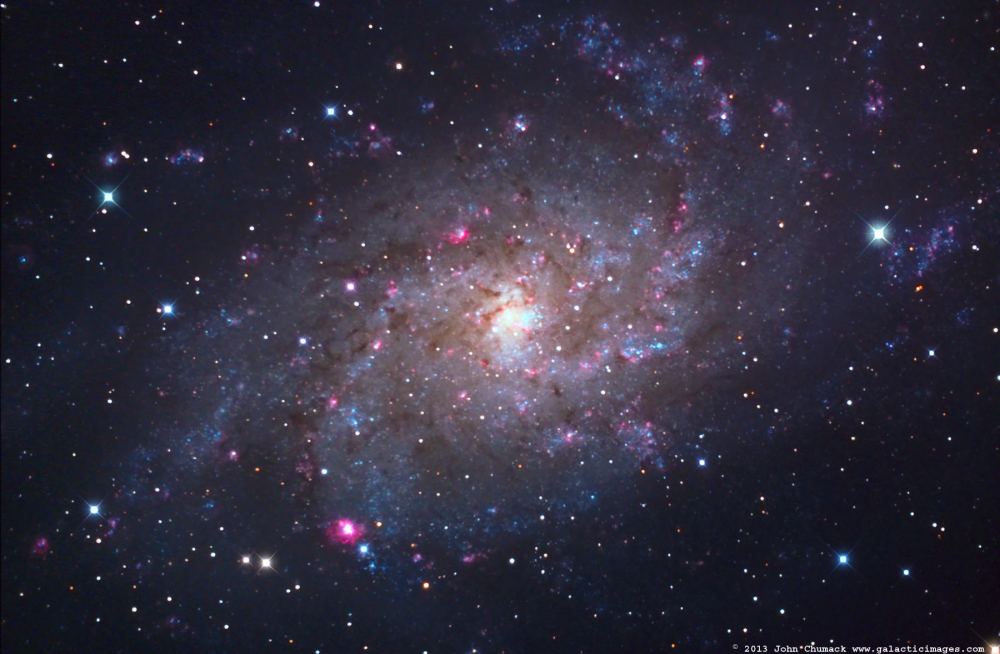Welcome back to Messier Monday! In our ongoing tribute to the great Tammy Plotner, we take a look at the Triangulum Galaxy, also known as Messier 33. Enjoy!
During the 18th century, famed French astronomer Charles Messier noted the presence of several “nebulous objects” in the night sky. Having originally mistaken them for comets, he began compiling a list of them so that others would not make the same mistake he did. In time, this list (known as the Messier Catalog) would come to include 100 of the most fabulous objects in the night sky.
One of these is the Triangulum Galaxy, a spiral galaxy located approximately 3 million light-years from Earth in the direction of the Triangulum constellation. As the third-largest member of the Local Group of galaxies (behind the Andromeda Galaxy and the Milky Way), it is the one of the most distant objects that can be seen with the naked eye. Much like M32, M33 is very close to Andromeda, and is believed to be a satellite of this major galaxy.
Description:
At some 3 million light years away from Earth, the Triangulum Galaxy is the third largest galaxy in our Local Group and it may be a gravitationally bound companion of the Andromeda Galaxy. Its beautiful spiral arms show multitudes of red HII regions and blue clouds of young stars. The largest of these HII regions (NGC 604) spans nearly 1500 across and is the largest so far known.

It has a spectrum similar to the Orion Nebula – our own Milky Way’s most celebrated starbirth region. “M33 is a gigantic laboratory where you can watch dust being created in novae and supernovae, being distributed in the winds of giant stars, and being reborn in new stars,” said University of Minnesota researcher and lead author Elisha Polomski. By studying M33, “you can see the Universe in a nutshell.”
Of course, our curiousity about our neighboring galaxy has driven us to try to understand more over the years. Once Edwin Hubble set the standard with Cepheid variables, we began measuring distance by discovering about 25 of them in M33. By 2004 we were studying the red giant star branch to peer even further. As A.W. McConnachie said in a 2004 study of the galaxy:
“The absolute bolometric luminosity of the point of core helium ignition in old, metal-poor, red giant stars is of roughly constant magnitude, varying only very slightly with mass or metallicity. It can thus be used as a standard candle. This technique then allows for the determination of realistic uncertainties which reflect the quality of the luminosity function used. Finally, we apply our technique to the Local Group spiral galaxy M33 and the dwarf galaxies Andromeda I and II, and derive distance. The result for M33 is in excellent agreement with the Cepheid distances to this galaxy, and makes the possibility of a significant amount of reddening in this object unlikely.”
By 2005, astronomers had detected two water masers on either side of M33 and for the first time ever – revealed what direction it as going in. According to Andreas Brunthaler (et al), who published a study about the distance and proper motion of the galaxy in 2005:
“We measured the angular rotation and proper motion of the Triangulum Galaxy (M33) with the Very Long Baseline Array by observing two H2O masers on opposite sides of the galaxy. By comparing the angular rotation rate with the inclination and rotation speed, we obtained a distance of 730 +/- 168 kiloparsecs. This distance is consistent with the most recent Cepheid distance measurement. This distance is consistent with the most recent Cepheid distance measurement. M33 is moving with a velocity of 190 +/- 59 kilometers per second relative to the Milky Way. These measurements promise a method to determine dynamical models for the Local Group and the mass and dark-matter halos of M31, M33, and the Milky Way.”
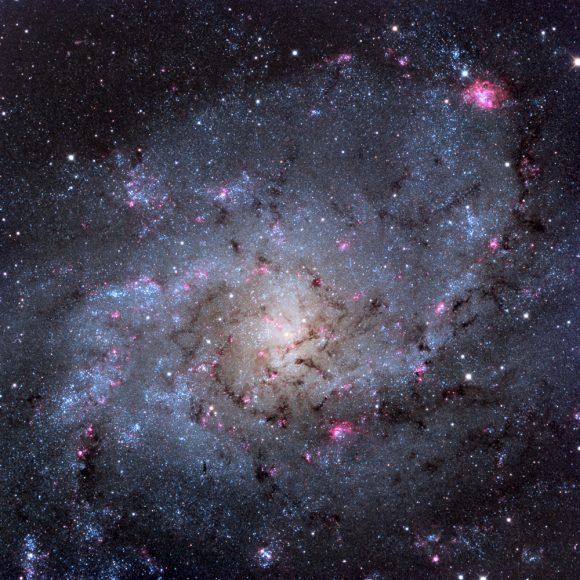
Yes, it’s moving toward the Andromeda Galaxy, much like how Andromeda is moving towards us! In 2006, a group of astronomers announced the discovery of an eclipsing binary star in M33. As A.Z. Bonanos, the lead author of the study that detailed the discovery, said:
“We present the first direct distance determination to a detached eclipsing binary in M33, which was found by the DIRECT Project. Located in the OB 66 association, it was one of the most suitable detached eclipsing binaries found by DIRECT for distance determination, given its 4.8938 day period.”
By studying the eclipsing binary, astronomers soon knew their size, distance, temperature and absolute magnitude. But more was yet to come! In 2007, the Chandra X-ray Observatory revealed even more when a black hole nearly 16 times the mass of the Sun was revealed. The black hole, named M33 X-7, orbits a companion star which it eclipses every 3.5 days. This means the companion star must also have an incredibly large mass as well….
Yet how huge must the parent star have been to have formed a black hole in advance of its companion? As Jerome Orosz, of San Diego State University, was quoted as saying in a 2007 Chandra press release:
“This discovery raises all sorts of questions about how such a big black hole could have been formed. Massive stars can be much less extravagant than people think by hanging onto a lot more of their mass toward the end of their lives. This can have a big effect on the black holes that these stellar time-bombs make.”
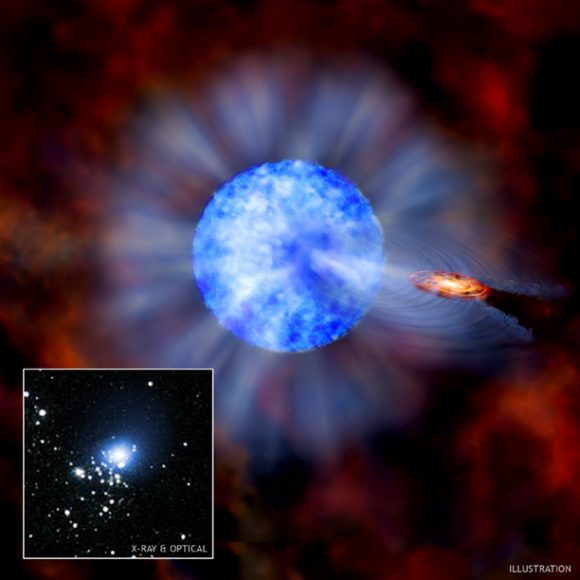
Stellar bombs? You bet. Gigantic stellar explosions even. Although no supernovae events have been detected in the Triangulum galaxy, it certainly doesn’t lack for evidence of supernova remnants. According to a 2004 study by F. Haberl and W. Pietsch of the Max-Planck-Institute:
“We present a catalogue of 184 X-ray sources within 50′ of the nucleus of the local group spiral galaxy M 33. The catalogue is derived from an analysis of the complete set of ROSAT archival data pointed in the direction of M 33 and contains X-ray position, existence likelihood, count rates and PSPC spectral hardness ratios. To identify the sources the catalog was correlated with previous X-ray catalogues, optical and radio catalogues. In addition sources were classified according to their X-ray properties. We find seven candidates for supersoft X-ray sources, of which two may be associated with known planetary nebulae in M 33. The majority of X-ray detected supernova remnants is also detected at radio frequencies and seen in optical lines. The low overall X-ray detection rate of optically selected SNRs can probably be attributed to their expansion into interstellar matter of low density.”
Or the creation of black holes…
History of Observation:
While the Triangulum Galaxy was probably first observed by Hodierna before 1654 (back when skies were dark), it was independently rediscovered by Charles Messier, and cataloged by him on August 25, 1764. As he recorded in his notes on the occasion:
“I have discovered a nebula between the head of the northern Fish and the large Triangle, a bit distant from a star which had not been known, of sixth magnitude, of which I have determined the position; the right ascension of that star was 22d 7′ 13″, and its declination 29d 54′ 10″ north: near that star, there is another one which is the first of Triangulum, described by the letter b. Flamsteed described it in his catalog, of sixth magnitude; it is less beautiful than that of which I have given the position, and one should set it to the rank of the stars of the eighth class. The nebula is a whitish light of 15 minutes in diameter, of an almost even density, despite a bit more luminous at two third of its diameter; it doesn’t contain any star: one sees it with difficulty with an ordinary refractor of one foot.”
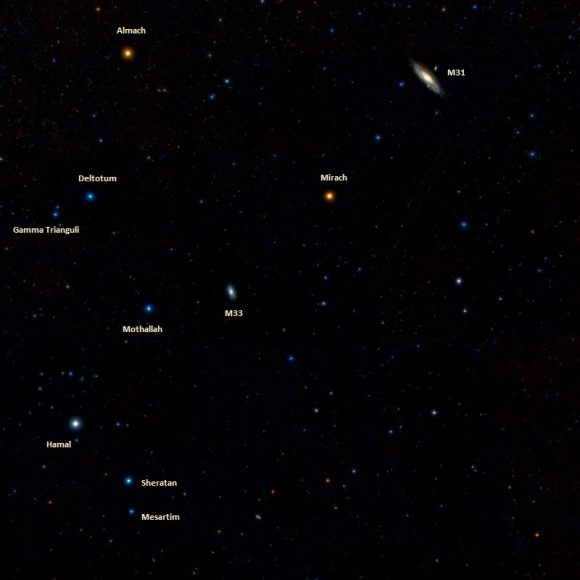
While Sir William Herschel wouldn’t publish papers on Messier’s findings, he was an astronomically curious soul and couldn’t help but study M33 intently on his own, writing:
“There is a suspicion that the nebula consists of exceedingly small stars. With this low power it has a nebulous appearance; and it vanishes when I put on the higher magnifying powers of 278 and 460.” He would continue to observe this grand galaxy again and again over the years, cataloging its various regions with their own separate numbers and keeping track of his findings: “The stars of the cluster are the smallest points imaginable. The diameter is nearly 18 minutes.”
Yet it would take a very special observer, one named Bill Parsons – the third Earl of Rosse – to become the very first to describe it as spiral. As he wrote of it:
“September 16, 1849. – New spiral: Alpha the brighter branch; Gamma faint; Delta short but pretty bright; Beta pretty distinct; Epsilon but suspected; the whole involved in a faint nebula, which probably extends past several knots which lie about it in different directions. Faint nebula seems to extend very far following: drawing taken.”
Quite the description indeed, since it would eventually lead to Rosse’s description of M33 being “…full of knots. Spiral arrangement. Two similar curves like an “S” cross in the center”, and to other astronomers discovering that these “spiral nebulae” were extra-galactic!
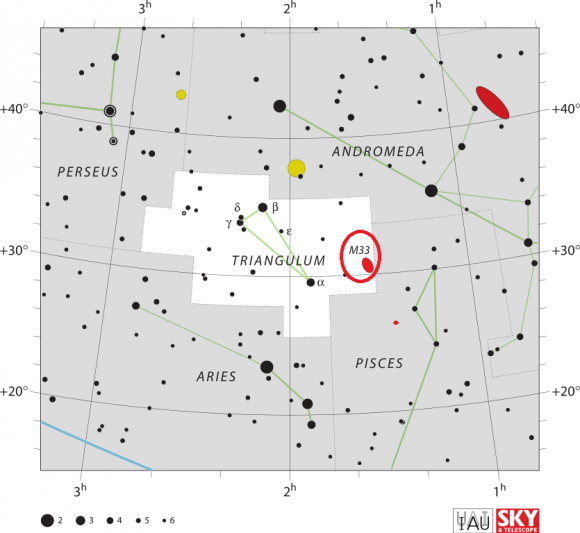
Locating Messier 33:
While actually locating Messier 33 isn’t so difficult, seeing Messier 33 can be. Even though it is billed at nearly unaided eye magnitude, this huge, low surface brightness galaxy requires some experience with equipment and observing conditions or you may hunt forever in the right place and never find it. Let’s begin first by getting you in the proper area! First locate the Great Square of Pegasus – and its easternmost bright star, Alpha. About a hand span further east you will see the brightest star in Triangulum – Alpha.
M33 is just a couple of degrees (about 2 finger widths) west. Now, the most important part to understand is that you must use the lowest magnification possible, or you won’t be able to see the proverbial forest because of the trees. The image you see here at the top of the page is around a full degree of sky – about 1/3 the field of view of average binoculars and far larger than your average telescope eyepiece.
However, by using the least amount of magnification with a telescope you are causing M33 to appear much smaller – allowing it to fit within eyepiece field of view range. The larger the aperture, the more light it gathers and the brighter the image will be. The next thing to understand is M33 really is low surface brightness… Light pollution, a fine haze in the sky, moonlight… All of these things will make it difficult to find. Yet, there are places left here on Earth where the Triangulum Galaxy can be seen with no optical aid at all!
Enjoy your quest for M33. You may find it your first time out and it may be years before you see it in all its glory. But when you do, we guarantee you’ll never forget! Be sure to enjoy this video of the Triangulum galaxy too, courtesy of the European Southern Observatory:
Enjoy your quest for M33. You may find it your first time out and it may be years before you see it in all its glory. But when you do, we guarantee you’ll never forget!
And here are the quick facts on M33 to help you get started:
Object Name: Messier 33
Alternative Designations: M33, NGC 598, Triangulum Galaxy, Pinwheel Galaxy
Object Type: Type Sc, Spiral Galaxy
Constellation: Triangulum
Right Ascension: 01 : 33.9 (h:m)
Declination: +30 : 39 (deg:m)
Distance: 3000 (kly)
Visual Brightness: 5.7 (mag)
Apparent Dimension: 73×45 (arc min)
We have written many interesting articles about Messier Objects here at Universe Today. Here’s Tammy Plotner’s Introduction to the Messier Objects, , M1 – The Crab Nebula, M8 – The Lagoon Nebula, and David Dickison’s articles on the 2013 and 2014 Messier Marathons.
Be to sure to check out our complete Messier Catalog. And for more information, check out the SEDS Messier Database.
Sources:

